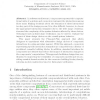Free Online Productivity Tools
i2Speak
i2Symbol
i2OCR
iTex2Img
iWeb2Print
iWeb2Shot
i2Type
iPdf2Split
iPdf2Merge
i2Bopomofo
i2Arabic
i2Style
i2Image
i2PDF
iLatex2Rtf
Sci2ools
ICSE
2007
IEEE-ACM
2007
IEEE-ACM
Plug-and-Play Architectural Design and Verification
Abstract. In software architecture, components represent the computational units of a system and connectors represent the interactions among those units. Making decisions about the semantics of these interactions is a key part of the design process. It is often difficult, however, to choose the appropriate interaction semantics due to the wide range of alternatives and the complexity of the system behavior affected by those choices. Techniques such as finite-state verification can be used to evaluate the impact of these design choices on the overall system behavior. This paper presents the Plug-and-Play approach that allows designers to experiment with alternative design choices of component interactions in a plug-and-play manner. With this approach, connectors representing specific interaction semantics are composed from a library of predefined, reusable building blocks. In addition, standard interfaces for components are defined that reduce the impact of interaction changes on the co...
Appropriate Interaction Semantics | Finite-state Verification | ICSE 2007 | Software Engineering | Specific Interaction Semantics |
| Added | 09 Dec 2009 |
| Updated | 09 Dec 2009 |
| Type | Conference |
| Year | 2007 |
| Where | ICSE |
| Authors | Shangzhu Wang, George S. Avrunin, Lori A. Clarke |
Comments (0)

